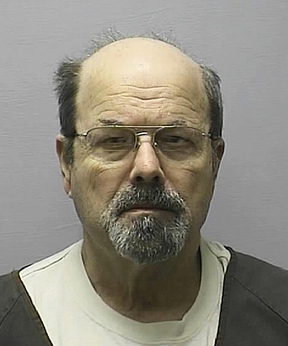Dennis Rader
Dennis Lynn Rader (born March 9, 1945) is an American serial killer known as the BTK killer or simply BTK, which stands for "Bind, Torture, Kill". Between 1974 and 1991, Rader killed ten people in and around Wichita, Kansas. His self-given nickname and his modus operandi of binding, torturing, and killing his victims brought him infamy. Rader eluded capture for decades, taunting law enforcement and the media with letters describing the details of his crimes. His arrest in 2005 and subsequent confession were a significant moment in American criminal history.
Early Life[edit | edit source]
Dennis Rader was born in Pittsburg, Kansas, but grew up in Wichita. He was the eldest of four sons. Little is known about his early life, but Rader himself has described having fantasies about tying up and dominating women from a young age. He served in the United States Air Force from 1966 to 1970, and upon discharge, he moved back to Wichita, where he worked in various jobs, including a position with the local ADT security services company, which later became a chilling detail given his future crimes.
Crimes[edit | edit source]
Rader's killing spree began in 1974 with the murder of four members of the Otero family in their home. This brutal crime shocked the Wichita community and marked the beginning of the BTK saga. Over the next several years, Rader would kill six more individuals, meticulously planning each attack and often breaking into victims' homes to wait for them. His method of operation involved binding his victims, torturing them, and then killing them, hence the moniker BTK.
Throughout his active years, Rader sent letters to police and local media outlets, taunting them with details of his crimes, puzzles, and cryptic messages. These communications ceased in 1979 but resumed in 2004, ultimately leading to his arrest.
Arrest and Conviction[edit | edit source]
In 2004, Rader resumed sending letters to the media, which led to a renewed interest in the case. A break in the case came when a floppy disk Rader sent was traced back to a computer at the Christ Lutheran Church, where he was a member. Further investigation linked him to the BTK killings, and he was arrested on February 25, 2005.
Rader confessed to all ten murders he was charged with and provided detailed accounts of his crimes. On August 18, 2005, he was sentenced to ten consecutive life terms without the possibility of parole. He is currently serving his sentence at the El Dorado Correctional Facility in Kansas.
Impact[edit | edit source]
The BTK killings had a profound impact on the Wichita community and the field of criminal investigation. Rader's ability to evade capture for so long, partly due to his position within the community and his knowledge of police investigation techniques, led to significant changes in how serial crimes are investigated.
In Popular Culture[edit | edit source]
Dennis Rader's crimes and the subsequent investigation have been the subject of numerous books, documentaries, and television series, reflecting the public's fascination with the case and the mind of a serial killer.
See Also[edit | edit source]
 This biography of a person notable in the field of crime or criminal justice is a stub. You can help WikiMD by expanding it.
This biography of a person notable in the field of crime or criminal justice is a stub. You can help WikiMD by expanding it.
Search WikiMD
Ad.Tired of being Overweight? Try W8MD's physician weight loss program.
Semaglutide (Ozempic / Wegovy and Tirzepatide (Mounjaro / Zepbound) available.
Advertise on WikiMD
|
WikiMD's Wellness Encyclopedia |
| Let Food Be Thy Medicine Medicine Thy Food - Hippocrates |
Translate this page: - East Asian
中文,
日本,
한국어,
South Asian
हिन्दी,
தமிழ்,
తెలుగు,
Urdu,
ಕನ್ನಡ,
Southeast Asian
Indonesian,
Vietnamese,
Thai,
မြန်မာဘာသာ,
বাংলা
European
español,
Deutsch,
français,
Greek,
português do Brasil,
polski,
română,
русский,
Nederlands,
norsk,
svenska,
suomi,
Italian
Middle Eastern & African
عربى,
Turkish,
Persian,
Hebrew,
Afrikaans,
isiZulu,
Kiswahili,
Other
Bulgarian,
Hungarian,
Czech,
Swedish,
മലയാളം,
मराठी,
ਪੰਜਾਬੀ,
ગુજરાતી,
Portuguese,
Ukrainian
Medical Disclaimer: WikiMD is not a substitute for professional medical advice. The information on WikiMD is provided as an information resource only, may be incorrect, outdated or misleading, and is not to be used or relied on for any diagnostic or treatment purposes. Please consult your health care provider before making any healthcare decisions or for guidance about a specific medical condition. WikiMD expressly disclaims responsibility, and shall have no liability, for any damages, loss, injury, or liability whatsoever suffered as a result of your reliance on the information contained in this site. By visiting this site you agree to the foregoing terms and conditions, which may from time to time be changed or supplemented by WikiMD. If you do not agree to the foregoing terms and conditions, you should not enter or use this site. See full disclaimer.
Credits:Most images are courtesy of Wikimedia commons, and templates, categories Wikipedia, licensed under CC BY SA or similar.
Contributors: Prab R. Tumpati, MD

